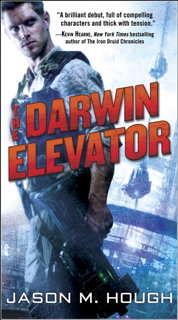 Cover for book one | |
The Darwin Elevator The Exodus Towers The Plague Forge | |
| Author | Jason M. Hough |
|---|---|
| Country | United States |
| Language | English |
| Genre | Science-fiction |
| Publisher | Del Rey Books (United States) Titan Books (United Kingdom) |
| Published | July 2013 – September 2013 |
| Media type | Print, ebook, audiobook |
| No. of books | 3 |
The Dire Earth Cycle is a trilogy of science fiction novels written by American author Jason M. Hough. [1] The series was simultaneously released in both the United States (by Del Rey Books) and the United Kingdom (by Titan Books). [2] The first book in the series, The Darwin Elevator, was released in July 2013, and the two sequels, The Exodus Towers and The Plague Forge, were released later that same year. [3] An eBook-only release, The Dire Earth: A Novella, acts as a prequel to the trilogy and reveals more of the main characters' backgrounds.
Contents
- Background
- Synopsis
- The Darwin Elevator
- The Exodus Towers
- The Plague Forge
- Development
- Reception
- References
- External links
Reception for The Darwin Elevator was extremely positive, and the book placed on The New York Times Best-Seller list. [4]